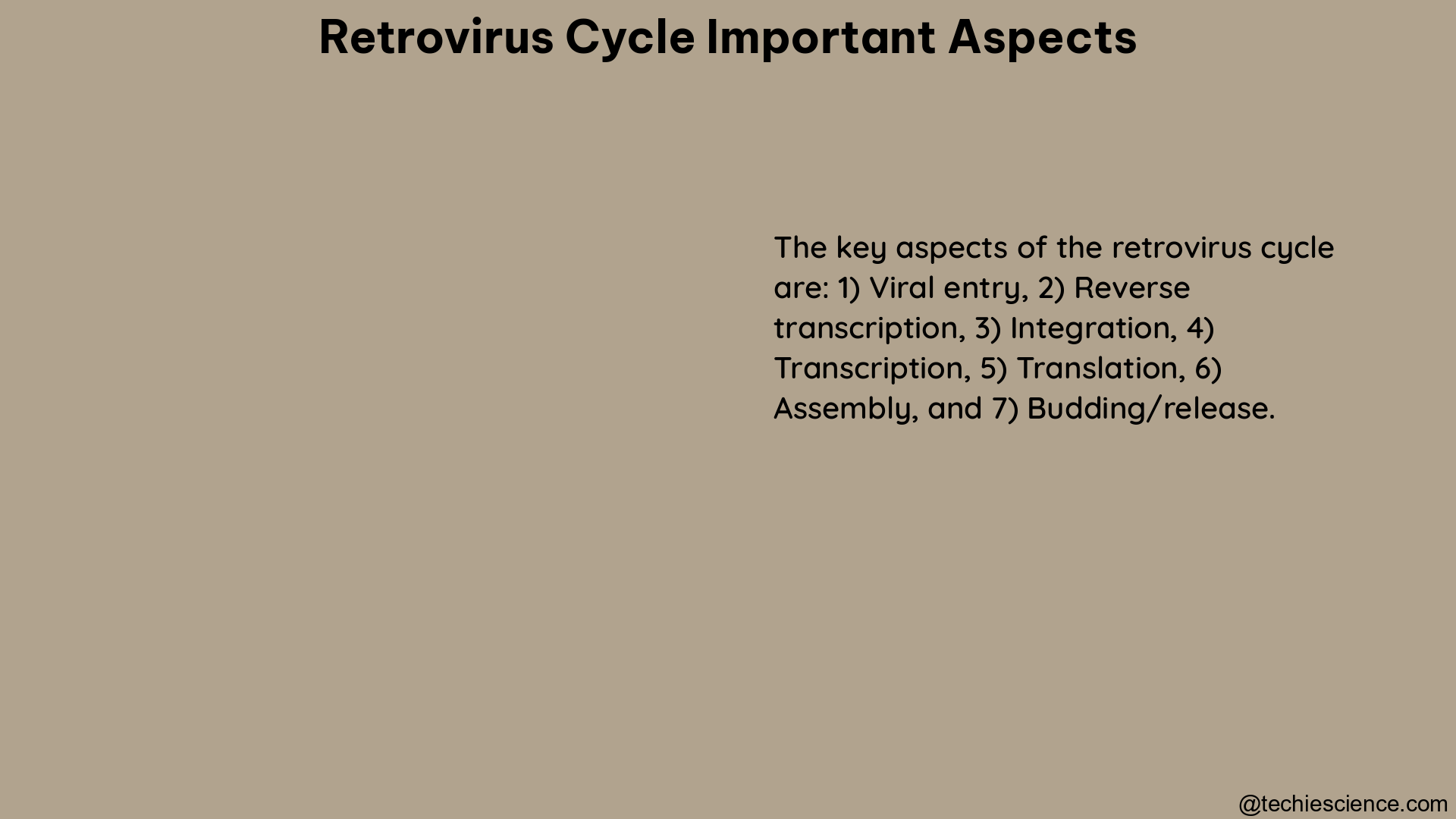The retrovirus cycle is a complex and intricate process that involves several critical steps, including reverse transcription, integration, and specific packaging of the viral genomic RNA (gRNA) as a dimer. Understanding the key aspects of this cycle is crucial for researchers, clinicians, and students alike, as it provides valuable insights into the biology of these viruses and their potential applications in gene therapy and vaccine development.
Reverse Transcription: The Cornerstone of Retroviral Replication
Reverse transcription is a fundamental step in the retrovirus cycle, where the viral RNA genome is converted into a double-stranded DNA (dsDNA) molecule. This process is catalyzed by the viral enzyme reverse transcriptase (RT), which possesses both RNA-dependent DNA polymerase and RNase H activities.
Error Rates during Reverse Transcription
Retroviral RT is known for its high error rate, which contributes to the remarkable genetic variability observed in these viruses. Studies have estimated the error rate of RT to be in the range of 3 × 10^-5 to 2 × 10^-4 mutations per base pair per replication cycle. This is significantly higher than the error rate of DNA polymerases, which is around 10^-10 mutations per base pair per replication cycle. The lack of a proofreading mechanism in RT is a key factor responsible for this high error rate, leading to a higher frequency of mutations during reverse transcription.
| Enzyme | Error Rate (mutations/base pair/replication cycle) |
|---|---|
| Retroviral Reverse Transcriptase (RT) | 3 × 10^-5 to 2 × 10^-4 |
| DNA Polymerases | ~10^-10 |
Factors Influencing Reverse Transcription Fidelity
Several factors can influence the fidelity of reverse transcription, including:
- Nucleotide pool imbalance: Imbalances in the availability of dNTPs can lead to increased misincorporation rates during reverse transcription.
- Divalent cation concentration: The concentration of Mg^2+ or Mn^2+ ions can affect the catalytic efficiency and fidelity of RT.
- Viral and host factors: Specific viral and host proteins, such as APOBEC3 cytidine deaminases, can modulate the fidelity of reverse transcription.
- Sequence context: The local sequence context can influence the error rate of RT, with certain sequence motifs being more prone to misincorporation.
Understanding these factors is crucial for developing strategies to mitigate the high error rate of retroviral RT and potentially improve the fidelity of reverse transcription.
Mutation Accumulation in Retroviruses

The high error rate of retroviral RT leads to a rapid accumulation of mutations during the replication cycle. Numerous studies have attempted to quantify the rate of mutation accumulation in retroviruses, with estimates ranging from 5 × 10^-6 to 5 × 10^-5 mutations per base pair per replication cycle.
| Virus | Mutation Rate (mutations/base pair/replication cycle) |
|---|---|
| Simian Sarcoma Virus (SNV) | 5 × 10^-6 to 5 × 10^-5 |
| Host DNA | ~10^-9 to 10^-10 |
This mutation rate is significantly higher than the mutation rate observed in host DNA, which is typically in the range of 10^-9 to 10^-10 mutations per base pair per replication cycle. The high mutation rate of retroviruses is a key factor contributing to their ability to rapidly evolve and adapt to changing environmental conditions, including the host immune response and the introduction of antiviral therapies.
Phylogenetic Analysis of Retroviral Sequences
Phylogenetic analysis is a powerful tool for reconstructing the evolutionary relationships and classification of retroviruses and related retroviral elements. As the accumulation of retroviral sequences in international DNA libraries has increased dramatically, the interpretation of these molecular sequences has become a growing challenge for retrovirologists.
Advances in Phylogenetic Algorithms
The SOPM (Structural Orthology Prediction Method) algorithm is a sophisticated tool that employs sizable subdatabases of retroviral sequences and their known secondary structures to infer phylogenetic relationships. This algorithm can take longer to run than older and less sophisticated methods, but it provides more accurate and reliable results, particularly for complex retroviral sequences.
Challenges in Retroviral Sequence Analysis
The rapid evolution and high genetic variability of retroviruses pose significant challenges for phylogenetic analysis. Factors such as recombination, horizontal gene transfer, and the presence of endogenous retroviral elements can complicate the interpretation of retroviral sequence data. Researchers must carefully consider these factors and employ advanced bioinformatics tools to accurately reconstruct the evolutionary history and relationships of these viruses.
Implications for Retrovirus Research and Applications
The key aspects of the retrovirus cycle, including reverse transcription, mutation accumulation, and phylogenetic analysis, have important implications for various areas of research and application:
- Antiretroviral drug development: Understanding the error rates and mutation dynamics of retroviruses can inform the design of more effective antiretroviral compounds that target the viral replication machinery.
- Vaccine development: Insights into the genetic variability of retroviruses can guide the development of broadly effective vaccines that can elicit a robust immune response against diverse viral strains.
- Retroviral-based gene therapy: The ability of retroviruses to efficiently integrate their genetic material into the host genome makes them valuable tools for gene therapy applications, but the high mutation rate must be carefully considered to ensure the safety and efficacy of these therapies.
- Evolutionary studies: Phylogenetic analysis of retroviral sequences provides valuable insights into the evolutionary history and relationships of these viruses, which can inform our understanding of their origins, host-virus interactions, and potential zoonotic transmission events.
In conclusion, the retrovirus cycle is a complex and dynamic process that involves several critical aspects, including reverse transcription, mutation accumulation, and phylogenetic analysis. By understanding these key aspects, researchers and clinicians can develop more effective strategies for combating retroviral infections, designing novel therapies, and harnessing the potential of retroviruses for various applications.
References:
- Special Biological Features of Reverse Transcription – Retroviruses. https://www.ncbi.nlm.nih.gov/books/NBK19422/
- Retroviral Sequences – Retroviruses – NCBI Bookshelf. https://www.ncbi.nlm.nih.gov/books/NBK19466/
- Understanding Retroviral Life Cycle and its Genomic RNA Packaging. https://www.sciencedirect.com/science/article/pii/S0022283622005514
- Fidelity of Reverse Transcription and Replication by Retroviral RNA-Dependent DNA Polymerases. https://www.ncbi.nlm.nih.gov/pmc/articles/PMC229342/
- Mutation Rates and Accumulation in Retroviral Genomes. https://www.ncbi.nlm.nih.gov/pmc/articles/PMC4524076/
- Phylogenetic Analysis of Retroviral Sequences. https://www.ncbi.nlm.nih.gov/pmc/articles/PMC3235586/

I am Abdullah Arsalan , Completed my PhD in Biotechnology. I have 7 years of research experience. I have published 6 papers so far in the journals of international repute with an average impact factor of 4.5 and few more are in consideration. I have presented research papers in various national and international conferences. My subject area of interest is biotechnology and biochemistry with special emphasis on Protein chemistry, enzymology, immunology, biophysical techniques and molecular biology.